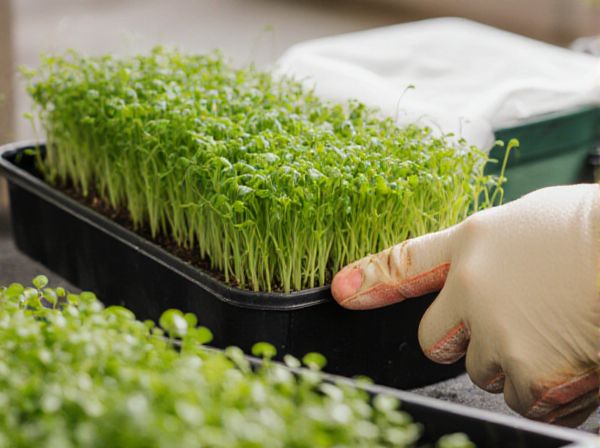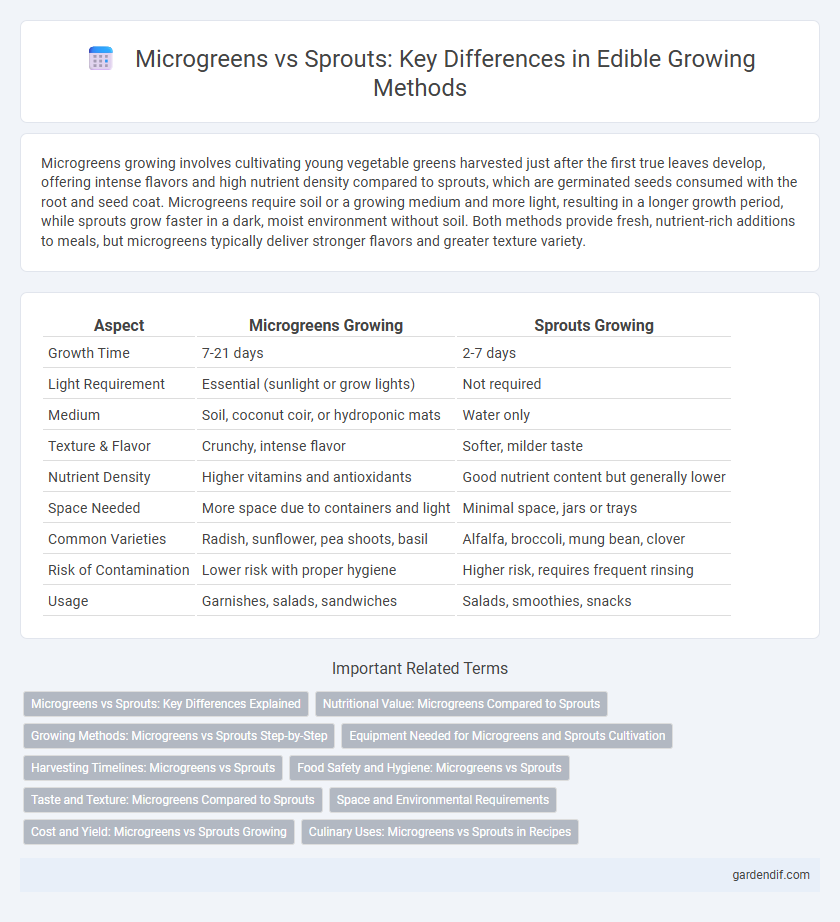
Microgreens Growing vs Sprouts Growing Illustration
Microgreens growing involves cultivating young vegetable greens harvested just after the first true leaves develop, offering intense flavors and high nutrient density compared to sprouts, which are germinated seeds consumed with the root and seed coat. Microgreens require soil or a growing medium and more light, resulting in a longer growth period, while sprouts grow faster in a dark, moist environment without soil. Both methods provide fresh, nutrient-rich additions to meals, but microgreens typically deliver stronger flavors and greater texture variety.
Table of Comparison
| Aspect | Microgreens Growing | Sprouts Growing |
|---|---|---|
| Growth Time | 7-21 days | 2-7 days |
| Light Requirement | Essential (sunlight or grow lights) | Not required |
| Medium | Soil, coconut coir, or hydroponic mats | Water only |
| Texture & Flavor | Crunchy, intense flavor | Softer, milder taste |
| Nutrient Density | Higher vitamins and antioxidants | Good nutrient content but generally lower |
| Space Needed | More space due to containers and light | Minimal space, jars or trays |
| Common Varieties | Radish, sunflower, pea shoots, basil | Alfalfa, broccoli, mung bean, clover |
| Risk of Contamination | Lower risk with proper hygiene | Higher risk, requires frequent rinsing |
| Usage | Garnishes, salads, sandwiches | Salads, smoothies, snacks |
Microgreens vs Sprouts: Key Differences Explained
Microgreens are harvested after 7-21 days when the first true leaves develop, offering a richer nutrient profile compared to sprouts, which are harvested within 2-7 days and include the seed, root, and stem. Microgreens require soil or a growing medium and light exposure for optimal growth, whereas sprouts grow in water without light, increasing the risk of bacterial contamination. The texture and flavor intensity differ significantly, with microgreens providing a tender, vibrant taste and sprouts delivering a crunchy, milder flavor.
Nutritional Value: Microgreens Compared to Sprouts
Microgreens contain higher concentrations of vitamins C, E, and K compared to sprouts, making them a more nutrient-dense option. The growth process of microgreens encourages greater synthesis of antioxidants and phytochemicals, enhancing their health benefits. Sprouts offer quick germination and a fresh taste but generally provide lower levels of essential nutrients than microgreens.
Growing Methods: Microgreens vs Sprouts Step-by-Step
Microgreens growing involves planting seeds in soil or a growth medium, providing water and light until the plants develop their first true leaves, typically harvested within 7-21 days. Sprouts growing requires soaking seeds for 6-12 hours, then rinsing and draining them multiple times daily in a sprouting container, with harvesting usually occurring in 3-7 days before leaves develop. The microgreens method emphasizes controlled light exposure and nutrient absorption through the medium, while sprouting focuses on hydration and air circulation to promote rapid germination.
Equipment Needed for Microgreens and Sprouts Cultivation
Microgreens growing requires shallow trays with drainage holes, high-quality soil or a growing medium, and adequate lighting, often using LED grow lights for optimal photosynthesis. Sprouts growing involves simpler equipment like jars or sprouting trays with mesh lids to rinse and drain seeds regularly, eliminating the need for soil or light. Precise temperature control devices enhance both methods, but the complexity and cost of microgreens equipment generally exceed that of sprout cultivation.
Harvesting Timelines: Microgreens vs Sprouts
Microgreens typically require 7 to 21 days from planting to harvest, allowing for optimal nutrient density and flavor development at the cotyledon stage. Sprouts, on the other hand, are ready for harvest within 2 to 7 days, as they are consumed at the germination stage before leaves develop. The longer growing period of microgreens results in higher vitamin concentrations and a more diverse nutrient profile compared to sprouts.
Food Safety and Hygiene: Microgreens vs Sprouts
Microgreens growing generally offers higher food safety due to cultivation in soil or growing mediums that reduce pathogen exposure compared to sprouts, which are grown in warm, humid conditions prone to bacterial contamination like Salmonella and E. coli. Proper hygiene practices and controlled environments are critical for both, but microgreens' above-soil growth allows better airflow and less moisture buildup, lowering microbial risks. Regular sanitization of tools and water quality monitoring are essential safety measures for ensuring both microgreens and sprouts remain safe for consumption.
Taste and Texture: Microgreens Compared to Sprouts
Microgreens offer a more intense flavor profile and a complex, crisp texture compared to sprouts, which tend to have a milder taste and softer, wetter consistency. The vibrant colors and delicate leaf structures of microgreens contribute to their enhanced sensory appeal in culinary applications. This distinct taste and texture make microgreens a preferred choice for gourmet dishes over the simpler, juniper-like freshness of sprouts.
Space and Environmental Requirements
Microgreens growing requires less water and thrives in well-lit, temperature-controlled environments with adequate airflow, making it ideal for small indoor spaces like windowsills or grow tents. Sprouts growing demands minimal space and no light, relying on warm, dark, and humid conditions, which can be maintained easily on countertops or in small containers. Efficient use of vertical space and precise environmental control are essential for optimizing yield in both microgreens and sprouts cultivation.
Cost and Yield: Microgreens vs Sprouts Growing
Microgreens growing requires higher initial investment in quality soil, trays, and LED lighting, whereas sprouts growing demands minimal equipment and is more cost-effective for beginners. Yield per square foot tends to be greater with microgreens due to their denser growth and longer growth cycle of 7-14 days compared to 3-7 days for sprouts. Despite higher costs, microgreens offer higher market value and larger harvests per batch, making them economically beneficial for commercial growers.
Culinary Uses: Microgreens vs Sprouts in Recipes
Microgreens offer vibrant color and intense flavor, elevating salads, sandwiches, and garnishes with their concentrated nutrients and crisp texture. Sprouts provide a crunchy, mild taste ideal for adding subtle freshness to wraps, stir-fries, and smoothies. Chefs often prefer microgreens for visually appealing plated dishes, while sprouts are favored for their versatility and ease of incorporation in raw and cooked recipes.
Microgreens Growing vs Sprouts Growing Infographic

 gardendif.com
gardendif.com